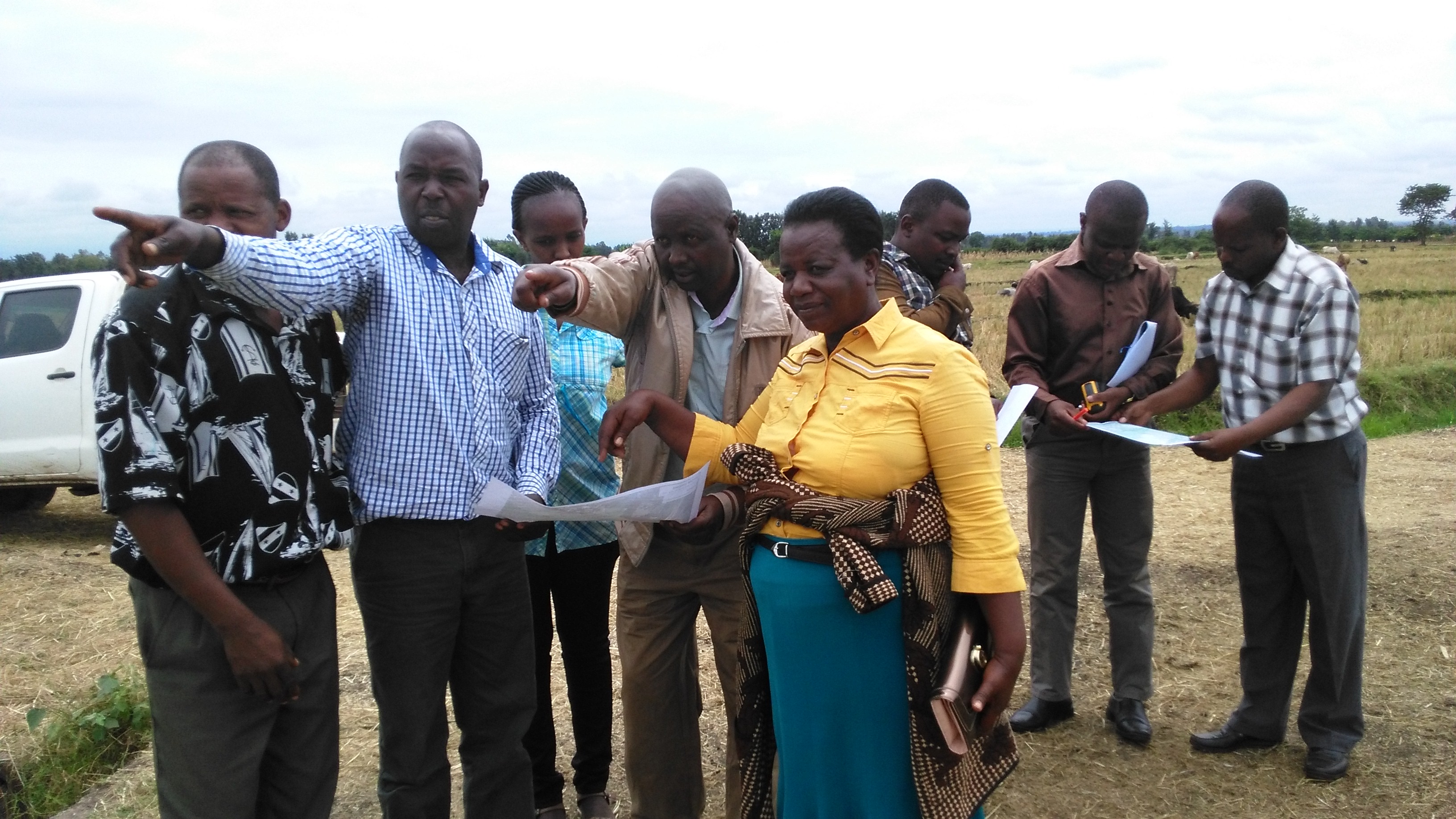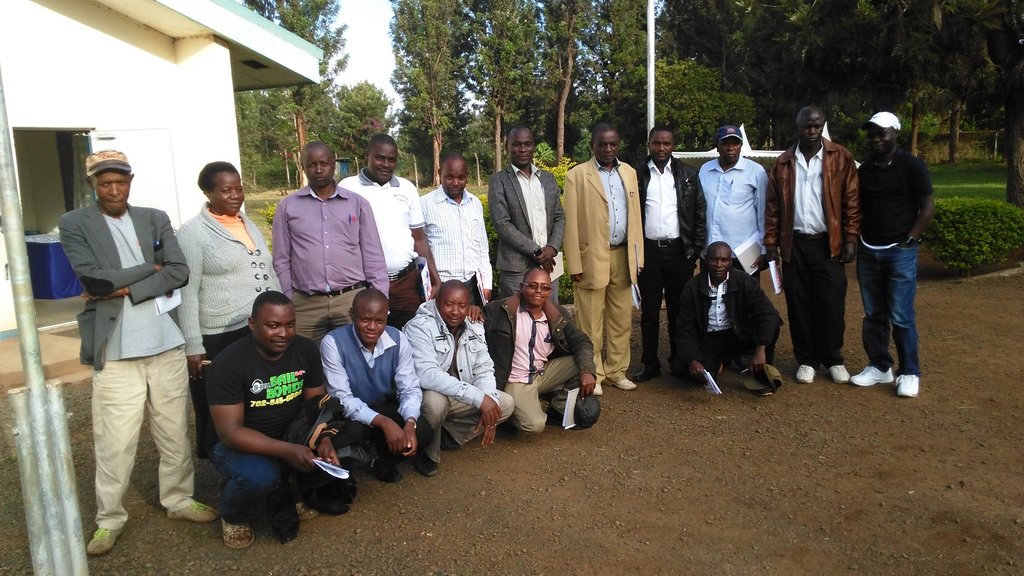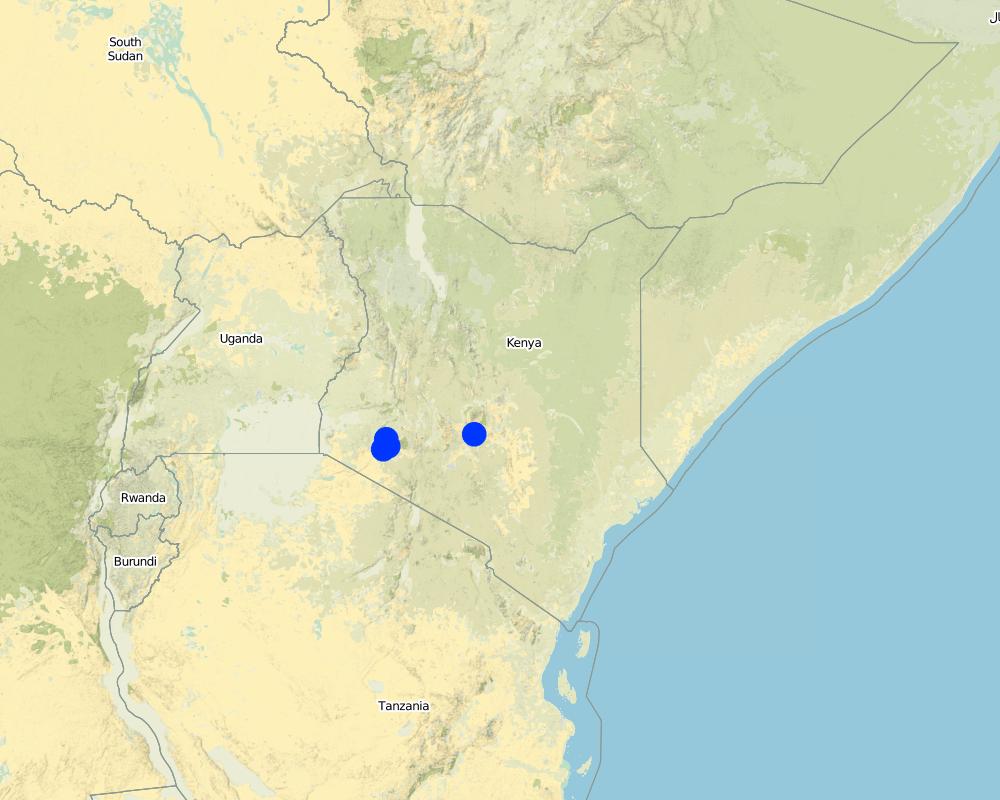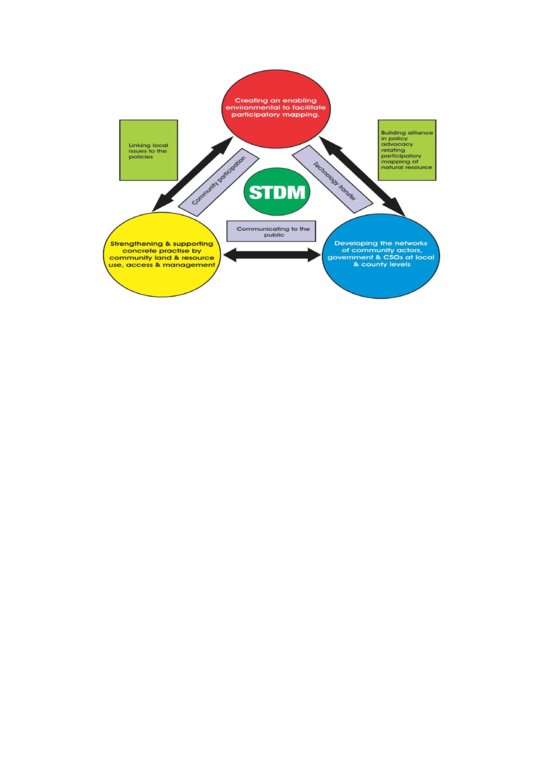Participatory Community Resource Mapping using Social Tenure Domain Model (STDM) [Kenya]
- Creation:
- Update:
- Compiler: Ken Otieno
- Editor: –
- Reviewer: Rima Mekdaschi Studer
STDM Project
approaches_3379 - Kenya
- Full summary as PDF
- Full summary as PDF for print
- Full summary in the browser
- Full summary (unformatted)
- Participatory Community Resource Mapping using Social Tenure Domain Model (STDM): March 5, 2018 (inactive)
- Participatory Community Resource Mapping using the Social Tenure Domain Model (STDM): May 19, 2018 (inactive)
- Participatory Community Resource Mapping using the Social Tenure Domain Model (STDM): June 4, 2018 (inactive)
- Participatory Community Resource Mapping using the Social Tenure Domain Model (STDM): Sept. 3, 2018 (public)
View sections
Expand all Collapse all1. General information
1.2 Contact details of resource persons and institutions involved in the assessment and documentation of the Approach
Key resource person(s)
SLM specialist:
Name of the institution(s) which facilitated the documentation/ evaluation of the Approach (if relevant)
Resource Conflict Institute (RECONCILE) - Kenya1.3 Conditions regarding the use of data documented through WOCAT
When were the data compiled (in the field)?
04/09/2017
The compiler and key resource person(s) accept the conditions regarding the use of data documented through WOCAT:
Yes
2. Description of the SLM Approach
2.1 Short description of the Approach
Social Tenure Domain Model (STDM) is about people and their relationships with land. The tool as applied secures tenure through the recognition of tenure diversity and social contexts. STDM recognizes that secure tenure builds confidence among the resource users and therefore promotes investments confidence at different levels including; small scale, large scale both urban and rural investors who all need secure tenure.
2.2 Detailed description of the Approach
Detailed description of the Approach:
The Rangelands Initiative Africa is a programme of the International Land Coalition (ILC) that is working to make rangelands more tenure secure. Resource Conflict Institute (RECONCILE) hosts and coordinates the Africa component while ILRI hosts and coordinates the Global component. Rangelands Initiatives existence recognizes that rangelands diverse resources and interests transcends across different stakeholders and therefore learning within these groups is important for strategic interventions and responses.
RECONCILE seeks to demonstrate the application the Social Tenure Domain Model (STDM) in a rural setting has been able to secure social tenure rights for increased production among smallholder farmers. This land management and tenure security programme sought to address the dynamics around common resources in Bomet. Recognizing that there are multiple claims to common resources; the technology uses the people as the central nexus in land administration. As such, an extensive range of systems and processes to manage land through effective and accurate planning and management.
Land as a factor of production attracts interests from stakeholders. As such, secure access to land, whether through formal, informal, customary or other means, is necessary for rural households to enjoy sustainable livelihoods, and is an important part of sustainable development. Securing access by rural poor people to land and water rights is key to the reduction of extreme poverty and hunger, since land and water are among the most important assets that poor rural women, youths and men have. Kenya has legal, policy and institutional frameworks and governance systems that presents options and opportunities.
STDM process involves, problem identification, stakeholder analysis, training, community enumeration, data collection both socio-economic and spatial data and total data management. The process allows an understanding and testing the extent STDM technology responded to gaps and how best they could be applied to cater for needs of all stakeholders within the rural, agricultural, communal land settings. The application of the technology demands complete data sets that are consolidated through total census of both resources users and resources.
2.3 Photos of the Approach
2.5 Country/ region/ locations where the Approach has been applied
Country:
Kenya
Region/ State/ Province:
Bomet county
Further specification of location:
Kembu sub-county
Comments:
The project implementation was done in three counties two of which the actual approach applied these are Bomet and Kirinya.
Map
×2.6 Dates of initiation and termination of the Approach
Indicate year of initiation:
2016
If precise year is not known, indicate approximate date when the Approach was initiated:
less than 10 years ago (recently)
Year of termination (if Approach is no longer applied):
2017
Comments:
Even though the project ended with the contract with the UNHABITAT, RECONCILE is still progressing with the approach in other areas
2.7 Type of Approach
- project/ programme based
2.8 Main aims/ objectives of the Approach
- Improve production
- Reduce, prevent, restore land degradation
- Conserve ecosystem
- Protect a watershed/ downstream areas
2.9 Conditions enabling or hindering implementation of the Technology/ Technologies applied under the Approach
social/ cultural/ religious norms and values
- enabling
The approach is participatory and the communities consent to the process taking leadership as such it is an enabler.
availability/ access to financial resources and services
- enabling
Based on secure tenure rights by way of confidence building, the communities as individual investors increase their investment and as a result increased income
institutional setting
- enabling
The approach is engaging and therefore flexible to inclusion of different institutions including government and private
collaboration/ coordination of actors
- enabling
Promotes partnership and collaboration
legal framework (land tenure, land and water use rights)
- enabling
Strengthens such frameworks as participatory resource securing process that reinforces accountability and services delivery. It recognizes the multiple tenure and resource rights
policies
- enabling
The STDM process is compatible with diverse policy frameworks that supports the use and management of communal resources.
land governance (decision-making, implementation and enforcement)
- hindering
In circumstances where land governance is not well defined, the process posses challenges and sometimes expectations and or lack of it undermines the process
3. Participation and roles of stakeholders involved
3.1 Stakeholders involved in the Approach and their roles
- local land users/ local communities
Small holder dairy farmers.
These farmers and community members were the key players in data collection, were the users of the approach and technology.
- SLM specialists/ agricultural advisers
GIS specialists, Lawyers, development experts.
Provided skills and expertise.
- NGO
Technical University of Kenya, Regional Centre for Mapping Resources for Development, Pamoja Trust.
All these institutions had a role in the project based on their previous engagement with UNHABITAT.
If several stakeholders were involved, indicate lead agency:
RECONCILE was the lead
3.2 Involvement of local land users/ local communities in the different phases of the Approach
| Involvement of local land users/ local communities | Specify who was involved and describe activities | |
|---|---|---|
| initiation/ motivation | interactive | The communities internalized the process and as such were very engaging and even self mobilized for the tasks |
| planning | interactive | Same as above |
| implementation | interactive | These were the key people in all the process of resource identification mapping and protection of both communal and private resources identified and mapped. |
| monitoring/ evaluation | self-mobilization | They still follow and report on status |
3.3 Flow chart (if available)
Description:
Using technology to enhance production among farmers need well thought approaches -Recognize diverse dynamics -Manage expectations
Author:
Ken Otieno
3.4 Decision-making on the selection of SLM Technology/ Technologies
Specify who decided on the selection of the Technology/ Technologies to be implemented:
- all relevant actors, as part of a participatory approach
Specify on what basis decisions were made:
- research findings
4. Technical support, capacity building, and knowledge management
4.1 Capacity building/ training
Was training provided to land users/ other stakeholders?
Yes
Specify who was trained:
- land users
- field staff/ advisers
Form of training:
- on-the-job
- farmer-to-farmer
- public meetings
4.2 Advisory service
Do land users have access to an advisory service?
Yes
Specify whether advisory service is provided:
- on land users' fields
- at permanent centres
Describe/ comments:
The users are beneficiaries of a government programme in the areas and were the basis against which the approach was used to close the gap.
4.3 Institution strengthening (organizational development)
Have institutions been established or strengthened through the Approach?
- yes, greatly
Specify the level(s) at which institutions have been strengthened or established:
- local
Specify type of support:
- capacity building/ training
- equipment
4.4 Monitoring and evaluation
Is monitoring and evaluation part of the Approach?
Yes
If yes, is this documentation intended to be used for monitoring and evaluation?
No
4.5 Research
Was research part of the Approach?
No
5. Financing and external material support
5.1 Annual budget for the SLM component of the Approach
If precise annual budget is not known, indicate range:
- 10,000-100,000
5.2 Financial/ material support provided to land users
Did land users receive financial/ material support for implementing the Technology/ Technologies?
No
5.3 Subsidies for specific inputs (including labour)
- none
If labour by land users was a substantial input, was it:
- voluntary
5.4 Credit
Was credit provided under the Approach for SLM activities?
No
5.5 Other incentives or instruments
Were other incentives or instruments used to promote implementation of SLM Technologies?
No
6. Impact analysis and concluding statements
6.1 Impacts of the Approach
Did the Approach empower local land users, improve stakeholder participation?
- No
- Yes, little
- Yes, moderately
- Yes, greatly
Communities and the programme benefited and revamped the resource management committees.
Did the Approach enable evidence-based decision-making?
- No
- Yes, little
- Yes, moderately
- Yes, greatly
The County governments greatly recognizes and appreciates the technology and approach to the extent that they will use the information and date in planning and resources allocation.
Did the Approach help land users to implement and maintain SLM Technologies?
- No
- Yes, little
- Yes, moderately
- Yes, greatly
Yes, the fact that the programme used local land users as key experts in the actual work has established local resources.
Did the Approach improve coordination and cost-effective implementation of SLM?
- No
- Yes, little
- Yes, moderately
- Yes, greatly
The partnership between and among government institutions have increased.
Did the Approach mobilize/ improve access to financial resources for SLM implementation?
- No
- Yes, little
- Yes, moderately
- Yes, greatly
The concept of the bigger programme was to support milk bulking and this has been achieved through improved resources use and management which in turn has enhanced milk produce; volume and quality.
Did the Approach improve knowledge and capacities of land users to implement SLM?
- No
- Yes, little
- Yes, moderately
- Yes, greatly
To the extent that the community resource users are directly involved in resource use and management, knowledge and skills are enhanced due to exposure and interactive sessions.
Did the Approach improve knowledge and capacities of other stakeholders?
- No
- Yes, little
- Yes, moderately
- Yes, greatly
The application of skills by local people influenced the thinking.
Partnership and collaborations developed
Did the Approach mitigate conflicts?
- No
- Yes, little
- Yes, moderately
- Yes, greatly
It was not the main thing though.
Did the Approach empower socially and economically disadvantaged groups?
- No
- Yes, little
- Yes, moderately
- Yes, greatly
They were not targeted directly but benefited from the wider community scope.
Did the Approach improve gender equality and empower women and girls?
- No
- Yes, little
- Yes, moderately
- Yes, greatly
Both men and women were equally involved in the process.
Did the Approach encourage young people/ the next generation of land users to engage in SLM?
- No
- Yes, little
- Yes, moderately
- Yes, greatly
The use if GPS was and incentive.
Did the Approach improve issues of land tenure/ user rights that hindered implementation of SLM Technologies?
- No
- Yes, little
- Yes, moderately
- Yes, greatly
The approach does not explicitly engage in issues of tenure but, in its implementation awareness is created.
Did the Approach lead to improved food security/ improved nutrition?
- No
- Yes, little
- Yes, moderately
- Yes, greatly
This can be acknowledged to some degree but needs a study on the project impact on nutrition.
Did the Approach improve access to markets?
- No
- Yes, little
- Yes, moderately
- Yes, greatly
Was not a direct concern but yes, it did based on more milk production.
Did the Approach lead to improved access to water and sanitation?
- No
- Yes, little
- Yes, moderately
- Yes, greatly
Yes clean water.
Did the Approach lead to more sustainable use/ sources of energy?
- No
- Yes, little
- Yes, moderately
- Yes, greatly
by enhanced use of bio gas yes.
Did the Approach improve the capacity of the land users to adapt to climate changes/ extremes and mitigate climate related disasters?
- No
- Yes, little
- Yes, moderately
- Yes, greatly
Did the Approach lead to employment, income opportunities?
- No
- Yes, little
- Yes, moderately
- Yes, greatly
6.2 Main motivation of land users to implement SLM
- increased production
6.3 Sustainability of Approach activities
Can the land users sustain what has been implemented through the Approach (without external support)?
- yes
If yes, describe how:
The approach application did not attract any material gains or incentives but, the process was community centered thus the adoption.
6.4 Strengths/ advantages of the Approach
| Strengths/ advantages/ opportunities in the land user’s view |
|---|
|
The approach was targeting identified problem that was felt by the actors/ implementer and communities in a joint mission. The approach demonstrated the capability to map livelihood resources of the rangeland users including those resources associated with milk production such as milk coolers, water points, cattle dips, food stores, grazing areas, salt licks, crush, animal corridors, forest e.t.c |
|
Collectively, communities were able to know the status (management) of communal shared resources and responsible persons. Establishment of the Land tenure system of shared communal resources and issues arising. Status (management) of private resources within the rangelands. |
| Strengths/ advantages/ opportunities in the compiler’s or other key resource person’s view |
|---|
| The approach uses participatory approach hence building community ownership. |
|
The mix of the approach bridges the gap through skills transfer and capacity building and in facilitating dialogue on issues affecting the community (Maps, reports). Ensures the adaptability of the process though technical, is simplified users can relate with and find value in their use contributed immense success. |
|
STDM database accommodate inclusion of social economic and spatial data that can be maintained, accessed and update by the communities anytime. Provided visual representation of available resources and their distribution and people can relate to spatial information on the map. |
|
Ownership of technology by local people who are now leading on data collection, customizing the template, developing reports and innovating on its use. |
|
|
6.5 Weaknesses/ disadvantages of the Approach and ways of overcoming them
| Weaknesses/ disadvantages/ risks in the land user’s view | How can they be overcome? |
|---|---|
| The design of the tool was a more urban oriented and took time to be adopted for rural use especially where land is communal and customs are key. | Created more awareness. |
| Weaknesses/ disadvantages/ risks in the compiler’s or other key resource person’s view | How can they be overcome? |
|---|---|
|
Difficult to setup the server environment where no internet is available. Engaging other service providers may be difficult and takes time (Internet service provider need to authorize setting up additional server). Appropriate devices for capturing data may necessity additional budget. |
The internet component remain a challenge. Technology is evolving and needs systematic information channels even with the community members. The process requires proper funding in order not to have a break in between. |
7. References and links
7.1 Methods/ sources of information
- field visits, field surveys
900
- interviews with land users
900
- interviews with SLM specialists/ experts
2
- compilation from reports and other existing documentation
7.3 Links to relevant information which is available online
Title/ description:
RECONCILE end of project report and other progress reports are available for sharing
Title/ description:
Food security in Bomet county
URL:
awsc.uonbi.ac.ke/sites/default/files/chss/arts/.../Bomet-final.doc
Links and modules
Expand all Collapse allLinks
No links
Modules
No modules






